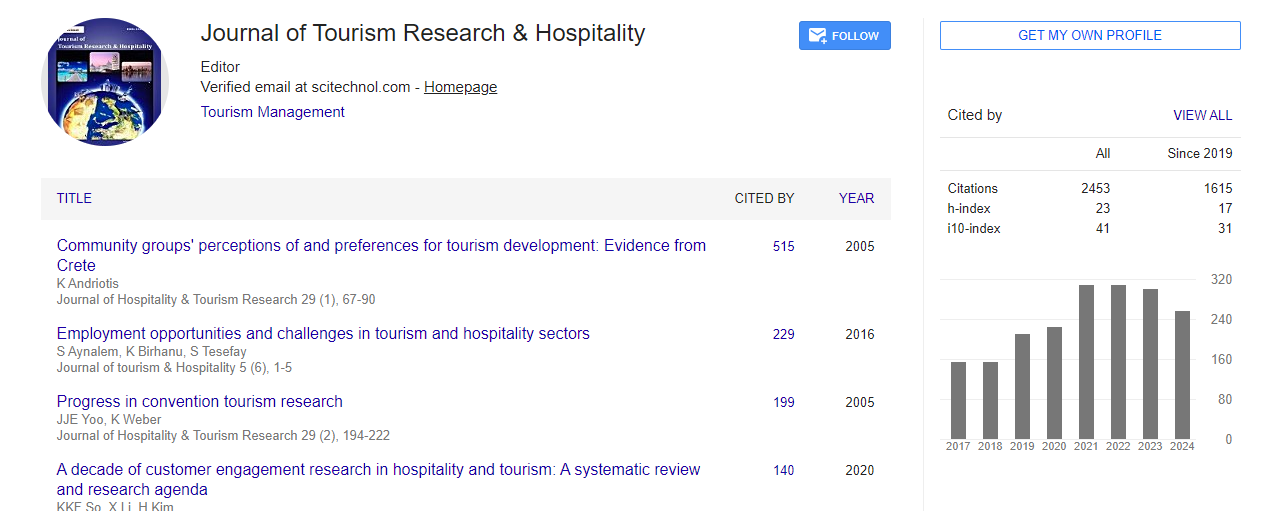Commentary, J Tourism Res Hospitality Vol: 13 Issue: 3
Curated Experience: Essential Highlights of Tourism
Tamura Mikoshiba*
1Department of Tourism Management, University of Tokyo, Tokyo, Japan
*Corresponding Author: Tamura Mikoshiba,
Department of Tourism Management,
University of Tokyo, Tokyo, Japan
E-mail: tamura.m@gmail.com
Received date: 24 May, 2024, Manuscript No. JTRH-24-143397;
Editor assigned date: 27 May, 2024, PreQC No. JTRH-24-143397 (PQ);
Reviewed date: 14 June, 2024, QC No. JTRH-24-143397;
Revised date: 21 June, 2024, Manuscript No. JTRH-24-143397 (R);
Published date: 28 June, 2024, DOI: 10.4172/2324-9110.1000189.
Citation: Mikoshiba T (2024) Curated Experience: Essential Highlights of Tourism. J Tourism Res Hospitality 13:3.
Description
Tourism campaigns are pivotal in shaping the image of a destination and attracting visitors. They serve as a strategic tool for destinations to communicate their unique offerings, engage potential travelers, and drive visitation. In an increasingly competitive global market, effective tourism campaigns can make the difference between a destination that thrives and one that remains overlooked. This study discovers the components of successful tourism campaigns, key strategies for implementation, and examples of campaigns that have achieved remarkable results. Establishing clear, measurable objectives is essential for any tourism campaign. Objectives may include increasing visitor numbers, boosting off-peak travel, enhancing brand awareness, or promoting specific attractions. Defining these goals helps in tailoring the campaign’s message and evaluating its success. Identifying and understanding the target audience is vital. This involves segmenting potential travellers based on demographics, psychographics, interests, and behaviours.
A successful campaign addresses the preferences and needs of these segments, ensuring that the message resonates with the intended audience. The USP highlights what sets the destination apart from others. This could be unique attractions, cultural experiences, natural beauty, or historical significance. Crafting a compelling USP helps differentiate the destination and generates a memorable impression in the minds of potential travellers. Content is the heart of any tourism campaign. It should be engaging, informative, and visually appealing. This includes crafting captivating stories, using high-quality images and videos, and providing relevant information that inspires and motivates potential travelers. Utilizing multiple channels to reach the target audience is key. This may include digital platforms traditional media and experiential marketing. A multi-channel approach ensures broader reach and increased visibility. Effective campaigns include a clear and compelling call to action. Whether it’s booking a trip, visiting a website, or following social media accounts, the CTA directs potential travelers towards the next step in the decision-making process. To assess the effectiveness of a tourism campaign, it is essential to measure and evaluate its impact. Metrics such as engagement rates, website traffic, conversion rates, and Return On Investment (ROI) provide insights into what worked well and what can be improved.
Strategies for implementing tourism campaigns
Effective storytelling captivates and engages audiences by creating an emotional connection. Share authentic stories about the destination’s culture, people, and experiences. Highlight personal anecdotes, testimonials, and local legends to make a compelling narrative. Collaborating with influencers and travel bloggers can amplify the campaign’s reach. Influencers have established trust and credibility with their followers, and their endorsements can significantly impact the perception of the destination. Choose influencers whose audience aligns with the target demographic. Interactive elements, such as virtual tours, augmented reality apps, or interactive maps, can enhance engagement. These tools allow potential travelers to experience the destination in a more immersive way, increasing their interest and likelihood of visiting. Tailoring the campaign’s message to different audience segments can improve relevance and effectiveness.
Aligning campaigns with seasonal trends or major events can capitalize on heightened interest and relevance. Promote special events, festivals, or seasonal activities to attract visitors during peak times or generate a sense of urgency with limited-time offers. Partnering with local businesses, attractions, and hospitality providers can enhance the campaign’s reach and credibility. Collaborative efforts can include joint promotions, bundled packages, or cross-promotional activities that benefit all parties involved. Continuously monitor the campaign’s performance and be prepared to adapt based on real-time feedback and data. Adjust strategies, messaging, and tactics as needed to optimize results and address any challenges that arise.
Challenges and considerations
Ensuring cultural sensitivity is essential in tourism campaigns. Avoid stereotypes, misrepresentations, or exploitation of local cultures. Engage with local communities to ensure that the campaign accurately reflects their values and traditions. Developing and executing a comprehensive tourism campaign can be costly. Destinations with limited budgets may need to prioritize their efforts, focusing on cost-effective strategies such as social media marketing, partnerships, and targeted content creation. The tourism industry is dynamic, with trends and preferences evolving rapidly. Campaigns must stay current with emerging trends and adapt to shifting interests, such as increasing demand for sustainable and authentic travel experiences. In a crowded market, differentiating a destination from its competitors can be challenging. Crafting a unique and compelling USP is essential to stand out and capture the attention of potential travelers.
Conclusion
Tourism campaigns play a vital role in promoting destinations, engaging travelers, and driving visitation. By integrating clear objectives, understanding target audiences, crafting compelling content, and utilizing a multi-channel approach, destinations can make effective campaigns that resonate with potential visitors. Successful campaigns leverage storytelling, influencer partnerships, interactive experiences, and personalization to captivate audiences and drive results.
 Spanish
Spanish  Chinese
Chinese  Russian
Russian  German
German  French
French  Japanese
Japanese  Portuguese
Portuguese  Hindi
Hindi 

